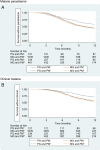Placental malaria and the risk of malaria in infants in a high malaria transmission area in ghana: a prospective cohort study
- PMID: 23908483
- PMCID: PMC3789576
- DOI: 10.1093/infdis/jit366
Placental malaria and the risk of malaria in infants in a high malaria transmission area in ghana: a prospective cohort study
Abstract
Background: Whether the risk of malaria is increased in infants born to mothers who experience malaria during pregnancy is uncertain.
Methods: We investigated malaria incidence among an infant cohort born to 355 primigravidae and 1500 multigravidae with or without placental malaria (PM) in a high malaria transmission area of Ghana. PM was assessed using placental histology.
Results: The incidence of all episodes of malaria parasitemia or clinical malaria was very similar among 3 groups of infants: those born to multigravidae without PM, multigravidae with PM, and primigravidae with PM. Infants born to primigravidae without PM experienced a lower incidence of malaria parasitemia or clinical malaria than the other 3 groups: adjusted hazard ratio, 0.64 (95% confidence interval [CI], .48-.86, P < .01) and 0.60 (95% CI, .43-.84, P < .01), respectively. The incidence of malaria parasitemia or clinical malaria was about 2 times higher in most poor infants compared to least poor infants.
Conclusions: There was no suggestion that exposure to PM directly increased incidence of malaria among infants of multigravidae. In our study area, absence of placental malaria in primigravidae is a marker of low exposure, and this probably explains the lower incidence of malaria-related outcomes among infants of PM-negative primigravidae.
Keywords: Ghana; cohort study; infant malaria; malaria; malaria epidemiology; placental malaria.
Figures



References
-
- Menendez C, Ordi J, Ismail MR, et al. The impact of placental malaria on gestational age and birth weight. J Infect Dis. 2000;181:1740–5. - PubMed
-
- Ordi J, Ismail MR, Ventura PJ, et al. Massive chronic intervillositis of the placenta associated with malaria infection. Am J Surg Pathol. 1998;22:1006–11. - PubMed
-
- McGregor IA, Wilson ME, Billewicz WZ. Malaria infection of the placenta in The Gambia, West Africa; its incidence and relationship to stillbirth, birthweight and placental weight. Trans R Soc Trop Med Hyg. 1983;77:232–44. - PubMed
-
- Le Hesran JY, Cot M, Personne P, et al. Maternal placental infection with Plasmodium falciparum and malaria morbidity during the first 2 years of life. Am J Epidemiol. 1997;146:826–31. - PubMed
Publication types
MeSH terms
Grants and funding
LinkOut - more resources
Full Text Sources
Other Literature Sources
Medical

